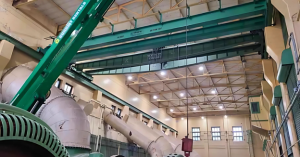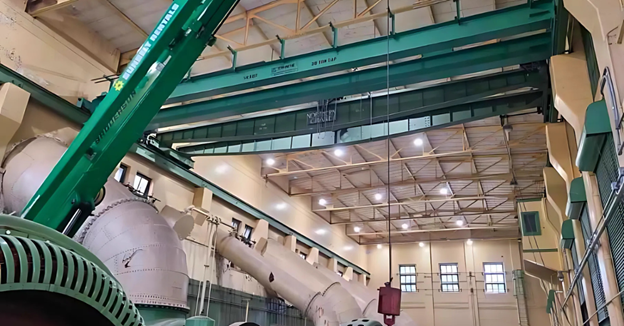Overhead cranes, while robust and reliable, are susceptible to unexpected breakdowns that can disrupt operations and pose safety risks. A swift and effective emergency response and recovery strategy is crucial for minimizing downtime and ensuring the safety of personnel and equipment.
As the leading provider of overhead crane solutions, our Crane 1 Services’ team understands the importance of preparedness and provides insights into the top five emergency response and recovery strategies for overhead cranes. This article outlines these strategies, empowering businesses to mitigate the impact of crane breakdowns and restore operations efficiently.

The Criticality of Emergency Response Planning
A well-defined emergency response plan is essential for any industrial operation utilizing overhead cranes. The plan should address potential breakdown scenarios, outline clear procedures, and assign responsibilities to ensure a coordinated and effective response. The benefits of a robust plan include:
- Minimized Downtime – Rapid response and recovery reduce the duration of operational disruptions.
- Enhanced Safety – Clear procedures and trained personnel minimize the risk of accidents during emergency situations.
- Reduced Financial Losses – Swift recovery minimizes production losses and repair costs.
- Improved Operational Resilience – A well-prepared team can effectively manage unexpected events, ensuring business continuity.
- Compliance – Many safety regulations require documented emergency procedures.
Emergency Response and Recovery Strategies
#1. Immediate Assessment and Isolation
Strategy: Upon detecting a crane breakdown, the first step is to immediately assess the situation and isolate the affected area to prevent further damage or injury.
Actions:
-
- Emergency Stop – Activate the emergency stop button to halt crane operation.
- Area Isolation – Isolate the area around the crane, preventing unauthorized access.
- Visual Inspection – Conduct a visual inspection to identify the apparent cause of the breakdown.
- Power Disconnection – If safe to do so, disconnect power to the crane at the main disconnect switch.
- Load Securement – If a load is suspended, ensure it is safely secured or lowered if possible, using secondary safety measures.
Importance: This immediate response prevents further damage and ensures the safety of personnel.
#2. Qualified Personnel Notification and Mobilization
Strategy: Promptly notify qualified personnel, including maintenance technicians, engineers, and safety officers, to assess and address the breakdown.
Actions:
-
- Emergency Contact List – Maintain an updated emergency contact list with contact information for qualified personnel.
- Rapid Mobilization – Ensure that qualified personnel can be rapidly mobilized to the breakdown site.
- Specialized Expertise – If necessary, contact external specialists or the crane manufacturer for assistance.
- Detailed Documentation – Ensure that personnel document the time of the event, and any observations.
Importance: Qualified personnel possess the expertise to diagnose and resolve complex crane breakdowns efficiently.
#3. Systematic Troubleshooting and Diagnosis
Strategy: Conduct a systematic troubleshooting and diagnosis process to identify the root cause of the breakdown.
Actions:
-
- Diagnostic Tools – Utilize diagnostic tools, such as multimeters, oscilloscopes, and load testing equipment, to identify electrical and mechanical faults.
- Systematic Approach – Follow a systematic troubleshooting approach, starting with the most likely causes and progressing to more complex issues.
- Manufacturer’s Manuals – Refer to the crane manufacturer’s manuals and technical documentation for guidance.
- Sensor Data – If the crane is equipped with sensors, use the stored data to help diagnose the issue.
- Component Inspection – Conduct thorough inspections of electrical and mechanical components, checking for damage, wear, and malfunction.
Importance: Accurate diagnosis is essential for effective repairs and preventing recurrence.
#4. Prioritized Repair and Component Replacement
Strategy: Develop a prioritized repair and component replacement plan, focusing on critical components and minimizing downtime.
Actions:
-
- Critical Component Identification – Identify critical components that require immediate repair or replacement.
- Parts Availability – Ensure that spare parts are readily available, either on-site or through reliable suppliers.
- Temporary Repairs – Implement temporary repairs if necessary to restore partial functionality and minimize downtime.
- Component Replacement – Replace damaged or worn components with genuine or approved replacements.
- Testing and Verification – Conduct thorough testing and verification after repairs to ensure proper functionality.
Importance: Prioritized repairs ensure that the crane is returned to service as quickly as possible.
#5. Post-Incident Analysis and Preventive Measures
Strategy: Conduct a thorough post-incident analysis to identify the root cause of the breakdown and implement preventive measures to prevent recurrence.
Actions:
-
- Root Cause Analysis – Perform a root cause analysis to identify the underlying factors that contributed to the breakdown.
- Preventive Maintenance Review – Review and update the preventive maintenance schedule to address identified weaknesses.
- Operator Training – Provide additional operator training to prevent misuse or overloading.
- System Upgrades – Consider system upgrades or modifications to improve reliability and safety.
- Documentation – Document the failure, the repair, and all of the steps taken to prevent future failures.
Importance: Post-incident analysis is essential for continuous improvement and preventing future breakdowns.
Overhead crane breakdowns can have significant consequences for industrial operations. By implementing the top five emergency response and recovery strategies outlined in this article, businesses can minimize downtime, enhance safety, and ensure operational resilience.
Crane 1 Services is committed to providing comprehensive overhead crane solutions, including emergency response planning, maintenance, and repairs, ensuring that your crane systems operate safely and reliably. Call (888) 316-2617 to receive a quote for our emergency overhead crane services!
